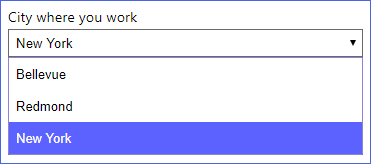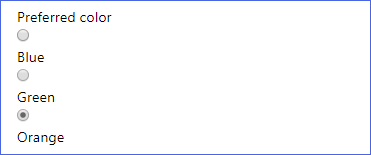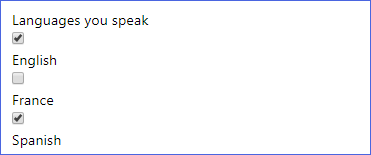Note
Access to this page requires authorization. You can try signing in or changing directories.
Access to this page requires authorization. You can try changing directories.
Important
Effective May 1, 2025, Azure AD B2C will no longer be available to purchase for new customers. Learn more in our FAQ.
Note
In Azure Active Directory B2C, custom policies are designed primarily to address complex scenarios. For most scenarios, we recommend that you use built-in user flows. If you've not done so, learn about custom policy starter pack in Get started with custom policies in Active Directory B2C.
The ClaimsSchema element defines the claim types that can be referenced as part of the policy. Claims schema is the place where you declare your claims. A claim can be first name, last name, display name, phone number and more. ClaimsSchema element contains list of ClaimType elements. The ClaimType element contains the Id attribute, which is the claim name.
<BuildingBlocks>
<ClaimsSchema>
<ClaimType Id="Id">
<DisplayName>Surname</DisplayName>
<DataType>string</DataType>
<DefaultPartnerClaimTypes>
<Protocol Name="OAuth2" PartnerClaimType="family_name" />
<Protocol Name="OpenIdConnect" PartnerClaimType="family_name" />
<Protocol Name="SAML2" PartnerClaimType="http://schemas.xmlsoap.org/ws/2005/05/identity/claims/surname" />
</DefaultPartnerClaimTypes>
<UserHelpText>Your surname (also known as family name or last name).</UserHelpText>
<UserInputType>TextBox</UserInputType>
ClaimType
The ClaimType element contains the following attribute:
| Attribute | Required | Description |
|---|---|---|
| Id | Yes | An identifier that's used for the claim type. Other elements can use this identifier in the policy. |
The ClaimType element contains the following elements:
| Element | Occurrences | Description |
|---|---|---|
| DisplayName | 1:1 | The title that's displayed to users on various screens. The value can be localized. |
| DataType | 1:1 | The type of the claim. |
| DefaultPartnerClaimTypes | 0:1 | The partner default claim types to use for a specified protocol. The value can be overwritten in the PartnerClaimType specified in the InputClaim or OutputClaim elements. Use this element to specify the default name for a protocol. |
| Mask | 0:1 | An optional string of masking characters that can be applied when displaying the claim. For example, the phone number 324-232-4343 can be masked as XXX-XXX-4343. |
| UserHelpText | 0:1 | A description of the claim type that can be helpful for users to understand its purpose. The value can be localized. |
| UserInputType | 0:1 | The type of input control that should be available to the user when manually entering the claim data for the claim type. See the user input types defined later in this page. |
| AdminHelpText | 0:1 | A description of the claim type that can be helpful for administrators to understand its purpose. |
| Restriction | 0:1 | The value restrictions for this claim, such as a regular expression (Regex) or a list of acceptable values. The value can be localized. |
| PredicateValidationReference | 0:1 | A reference to a PredicateValidationsInput element. The PredicateValidationReference elements enable you to perform a validation process to ensure that only properly formed data is entered. For more information, see Predicates. |
DataType
The DataType element supports the following values:
| Type | Description |
|---|---|
| boolean | Represents a Boolean (true or false) value. |
| date | Represents an instant in time, typically expressed as a date of a day. The value of the date follows ISO 8601 convention. |
| dateTime | Represents an instant in time, typically expressed as a date and time of day. The value of the date follows ISO 8601 convention during runtime and is converted to UNIX epoch time when issued as a claim into the token. |
| duration | Represents a time interval in years, months, days, hours, minutes, and seconds. The format of is PnYnMnDTnHnMnS, where P indicates positive, or N for negative value. nY is the number of years followed by a literal Y. nMo is the number of months followed by a literal Mo. nD is the number of days followed by a literal D. Examples: P21Y represents 21 years. P1Y2Mo represents one year, and two months. P1Y2Mo5D represents one year, two months, and five days. P1Y2M5DT8H5M20S represents one year, two months, five days, eight hours, five minutes, and twenty seconds. |
| phoneNumber | Represents a phone number. |
| int | Represents number between -2,147,483,648 and 2,147,483,647 |
| long | Represents number between -9,223,372,036,854,775,808 to 9,223,372,036,854,775,807 |
| string | Represents text as a sequence of UTF-16 code units. |
| stringCollection | Represents a collection of string. |
| userIdentity | Represents a user identity. |
| userIdentityCollection | Represents a collection of userIdentity. |
DefaultPartnerClaimTypes
The DefaultPartnerClaimTypes may contain the following element:
| Element | Occurrences | Description |
|---|---|---|
| Protocol | 1:n | List of protocols with their default partner claim type name. |
The Protocol element contains the following attributes:
| Attribute | Required | Description |
|---|---|---|
| Name | Yes | The name of a valid protocol supported by Azure AD B2C. Possible values are: OAuth1, OAuth2, SAML2, OpenIdConnect. |
| PartnerClaimType | Yes | The claim type name to be used. |
In the following example, when the Identity Experience Framework interacts with a SAML2 identity provider or relying party application, the surname claim is mapped to http://schemas.xmlsoap.org/ws/2005/05/identity/claims/surname, with OpenIdConnect and OAuth2, the claim is mapped to family_name.
<ClaimType Id="surname">
<DisplayName>Surname</DisplayName>
<DataType>string</DataType>
<DefaultPartnerClaimTypes>
<Protocol Name="OAuth2" PartnerClaimType="family_name" />
<Protocol Name="OpenIdConnect" PartnerClaimType="family_name" />
<Protocol Name="SAML2" PartnerClaimType="http://schemas.xmlsoap.org/ws/2005/05/identity/claims/surname" />
</DefaultPartnerClaimTypes>
</ClaimType>
As a result, the JWT issued by Azure AD B2C, emits the family_name instead of ClaimType name surname.
{
"sub": "aaaaaaaa-0000-1111-2222-bbbbbbbbbbbb",
"auth_time": 1535013501,
"given_name": "David",
"family_name": "Williams",
"name": "David Williams",
}
Mask
The Mask element contains the following attributes:
| Attribute | Required | Description |
|---|---|---|
Type |
Yes | The type of the claim mask. Possible values: Simple or Regex. The Simple value indicates that a simple text mask is applied to the leading portion of a string claim. The Regex value indicates that a regular expression is applied to the string claim as whole. If the Regex value is specified, an optional attribute must also be defined with the regular expression to use. |
Regex |
No | If Type is set to Regex, specify the regular expression to use. |
The following example configures a PhoneNumber claim with the Simple mask. For more samples, check out the Claim simple mask live demo.
<ClaimType Id="PhoneNumber">
<DisplayName>Phone Number</DisplayName>
<DataType>string</DataType>
<Mask Type="Simple">XXX-XXX-</Mask>
<UserHelpText>Your telephone number.</UserHelpText>
</ClaimType>
The Identity Experience Framework renders the phone number while hiding the first six digits:

The following example configures a AlternateEmail claim with the Regex mask. For more samples, check out the Regex mask live demo.
<ClaimType Id="AlternateEmail">
<DisplayName>Please verify the secondary email linked to your account</DisplayName>
<DataType>string</DataType>
<Mask Type="Regex" Regex="(?<=.).(?=.*@)">*</Mask>
<UserInputType>Readonly</UserInputType>
</ClaimType>
The Identity Experience Framework renders only the first letter of the email address and the email domain name:

Restriction
The Restriction element may contain the following attribute:
| Attribute | Required | Description |
|---|---|---|
| MergeBehavior | No | The method used to merge enumeration values with a ClaimType in a parent policy with the same identifier. Use this attribute when you overwrite a claim specified in the base policy. Possible values: Append, Prepend, or ReplaceAll. The Append value is a collection of data that should be appended to the end of the collection specified in the parent policy. The Prepend value is a collection of data that should be added before the collection specified in the parent policy. The ReplaceAll value is a collection of data specified in the parent policy that should be ignored. |
The Restriction element contains the following elements:
| Element | Occurrences | Description |
|---|---|---|
| Enumeration | 1:n | The available options in the user interface for the user to select for a claim, such as a value in a dropdown. |
| Pattern | 1:1 | The regular expression to use. |
Enumeration
The Enumeration element defines available options for the user to select for a claim in the user interface, such as a value in a CheckboxMultiSelect, DropdownSingleSelect, or RadioSingleSelect. Alternatively, you can define and localize available options with LocalizedCollections element. To look up an item from a claim Enumeration collection, use GetMappedValueFromLocalizedCollection claims transformation.
The Enumeration element contains the following attributes:
| Attribute | Required | Description |
|---|---|---|
| Text | Yes | The display string that is shown to the user in the user interface for this option. |
| Value | Yes | The claim value that is associated with selecting this option. |
| SelectByDefault | No | Indicates whether or not this option should be selected by default in the UI. Possible values: True or False. |
The following example configures a city dropdown list claim with a default value set to New York. For more samples, check out the Claim restriction enumeration live demo.
<ClaimType Id="city">
<DisplayName>city where you work</DisplayName>
<DataType>string</DataType>
<UserInputType>DropdownSingleSelect</UserInputType>
<Restriction>
<Enumeration Text="Bellevue" Value="bellevue" SelectByDefault="false" />
<Enumeration Text="Redmond" Value="redmond" SelectByDefault="false" />
<Enumeration Text="New York" Value="new-york" SelectByDefault="true" />
</Restriction>
</ClaimType>
Dropdown city list with a default value set to New York:

Pattern
The Pattern element can contain the following attributes:
| Attribute | Required | Description |
|---|---|---|
| RegularExpression | Yes | The regular expression that claims of this type must match in order to be valid. |
| HelpText | No | An error message for users if the regular expression check fails. |
The following example configures an email claim with regular expression input validation and help text:
<ClaimType Id="email">
<DisplayName>Email Address</DisplayName>
<DataType>string</DataType>
<DefaultPartnerClaimTypes>
<Protocol Name="OpenIdConnect" PartnerClaimType="email" />
</DefaultPartnerClaimTypes>
<UserHelpText>Email address that can be used to contact you.</UserHelpText>
<UserInputType>TextBox</UserInputType>
<Restriction>
<Pattern RegularExpression="^[a-zA-Z0-9.+!#$%&'+^_`{}~-]+(?:\.[a-zA-Z0-9!#$%&'+^_`{}~-]+)*@(?:[a-zA-Z0-9](?:[a-zA-Z0-9-]*[a-zA-Z0-9])?\.)+[a-zA-Z0-9](?:[a-zA-Z0-9-]*[a-zA-Z0-9])?$" HelpText="Please enter a valid email address." />
</Restriction>
</ClaimType>
The Identity Experience Framework renders the email address claim with email format input validation:

UserInputType
Azure AD B2C supports a variety of user input types, such as a textbox, password, and dropdown list that can be used when manually entering claim data for the claim type. You must specify the UserInputType when you collect information from the user by using a self-asserted technical profile and display controls.
Check out the Live demo of the user input type.
The UserInputType element available user input types:
| UserInputType | Supported ClaimType | Description |
|---|---|---|
| CheckboxMultiSelect | string |
Multi select drop-down box. The claim value is represented in a comma delimiter string of the selected values. |
| DateTimeDropdown | date, dateTime |
Drop-downs to select a day, month, and year. |
| DropdownSingleSelect | string |
Single select drop-down box. The claim value is the selected value. |
| EmailBox | string |
Email input field. |
| Paragraph | boolean, date, dateTime, duration, int, long, string |
A field that shows text only in a paragraph tag. |
| Password | string |
Password text box. |
| RadioSingleSelect | string |
Collection of radio buttons. The claim value is the selected value. |
| Readonly | boolean, date, dateTime, duration, int, long, string |
Read-only text box. |
| TextBox | boolean, int, phoneNumber, string |
Single-line text box. |
TextBox
The TextBox user input type is used to provide a single-line text box.

<ClaimType Id="displayName">
<DisplayName>Display Name</DisplayName>
<DataType>string</DataType>
<UserHelpText>Your display name.</UserHelpText>
<UserInputType>TextBox</UserInputType>
</ClaimType>
EmailBox
The EmailBox user input type is used to provide a basic email input field.

<ClaimType Id="email">
<DisplayName>Email Address</DisplayName>
<DataType>string</DataType>
<UserHelpText>Email address that can be used to contact you.</UserHelpText>
<UserInputType>EmailBox</UserInputType>
<Restriction>
<Pattern RegularExpression="^[a-zA-Z0-9.+!#$%&'+^_`{}~-]+(?:\.[a-zA-Z0-9!#$%&'+^_`{}~-]+)*@(?:[a-zA-Z0-9](?:[a-zA-Z0-9-]*[a-zA-Z0-9])?\.)+[a-zA-Z0-9](?:[a-zA-Z0-9-]*[a-zA-Z0-9])?$" HelpText="Please enter a valid email address." />
</Restriction>
</ClaimType>
Password
The Password user input type is used to record a password entered by the user.

<ClaimType Id="password">
<DisplayName>Password</DisplayName>
<DataType>string</DataType>
<UserHelpText>Enter password</UserHelpText>
<UserInputType>Password</UserInputType>
</ClaimType>
DateTimeDropdown
The DateTimeDropdown user input type is used to provide a set of drop-downs to select a day, month, and year. You can use Predicates and PredicateValidations elements to control the minimum and maximum date values. For more information, see the Configure a date range section of Predicates and PredicateValidations.

<ClaimType Id="dateOfBirth">
<DisplayName>Date Of Birth</DisplayName>
<DataType>date</DataType>
<UserHelpText>The date on which you were born.</UserHelpText>
<UserInputType>DateTimeDropdown</UserInputType>
</ClaimType>
RadioSingleSelect
The RadioSingleSelect user input type is used to provide a collection of radio buttons that allows the user to select one option.

<ClaimType Id="color">
<DisplayName>Preferred color</DisplayName>
<DataType>string</DataType>
<UserInputType>RadioSingleSelect</UserInputType>
<Restriction>
<Enumeration Text="Blue" Value="Blue" SelectByDefault="false" />
<Enumeration Text="Green " Value="Green" SelectByDefault="false" />
<Enumeration Text="Orange" Value="Orange" SelectByDefault="true" />
</Restriction>
</ClaimType>
DropdownSingleSelect
The DropdownSingleSelect user input type is used to provide a drop-down box that allows the user to select one option.

<ClaimType Id="city">
<DisplayName>City where you work</DisplayName>
<DataType>string</DataType>
<UserInputType>DropdownSingleSelect</UserInputType>
<Restriction>
<Enumeration Text="Bellevue" Value="bellevue" SelectByDefault="false" />
<Enumeration Text="Redmond" Value="redmond" SelectByDefault="false" />
<Enumeration Text="New York" Value="new-york" SelectByDefault="true" />
</Restriction>
</ClaimType>
CheckboxMultiSelect
The CheckboxMultiSelect user input type is used to provide a collection of checkboxes that allows the user to select multiple options.

<ClaimType Id="languages">
<DisplayName>Languages you speak</DisplayName>
<DataType>string</DataType>
<UserInputType>CheckboxMultiSelect</UserInputType>
<Restriction>
<Enumeration Text="English" Value="English" SelectByDefault="true" />
<Enumeration Text="France " Value="France" SelectByDefault="false" />
<Enumeration Text="Spanish" Value="Spanish" SelectByDefault="false" />
</Restriction>
</ClaimType>
Readonly
The Readonly user input type is used to provide a readonly field to display the claim and value.

<ClaimType Id="membershipNumber">
<DisplayName>Membership number</DisplayName>
<DataType>string</DataType>
<UserHelpText>Your membership number (read only)</UserHelpText>
<UserInputType>Readonly</UserInputType>
</ClaimType>
Paragraph
The Paragraph user input type is used to provide a field that shows text only in a paragraph tag. For example, <p>text</p>. A Paragraph user input type OutputClaim of self-asserted technical profile, must set the Required attribute false (default). This user input type is only supported in self-asserted page layouts. Unified sign-in and sign-up pages (unifiedssp) might not display this properly.

<ClaimType Id="responseMsg">
<DisplayName>Error message: </DisplayName>
<DataType>string</DataType>
<AdminHelpText>A claim responsible for holding response messages to send to the relying party</AdminHelpText>
<UserHelpText>A claim responsible for holding response messages to send to the relying party</UserHelpText>
<UserInputType>Paragraph</UserInputType>
</ClaimType>